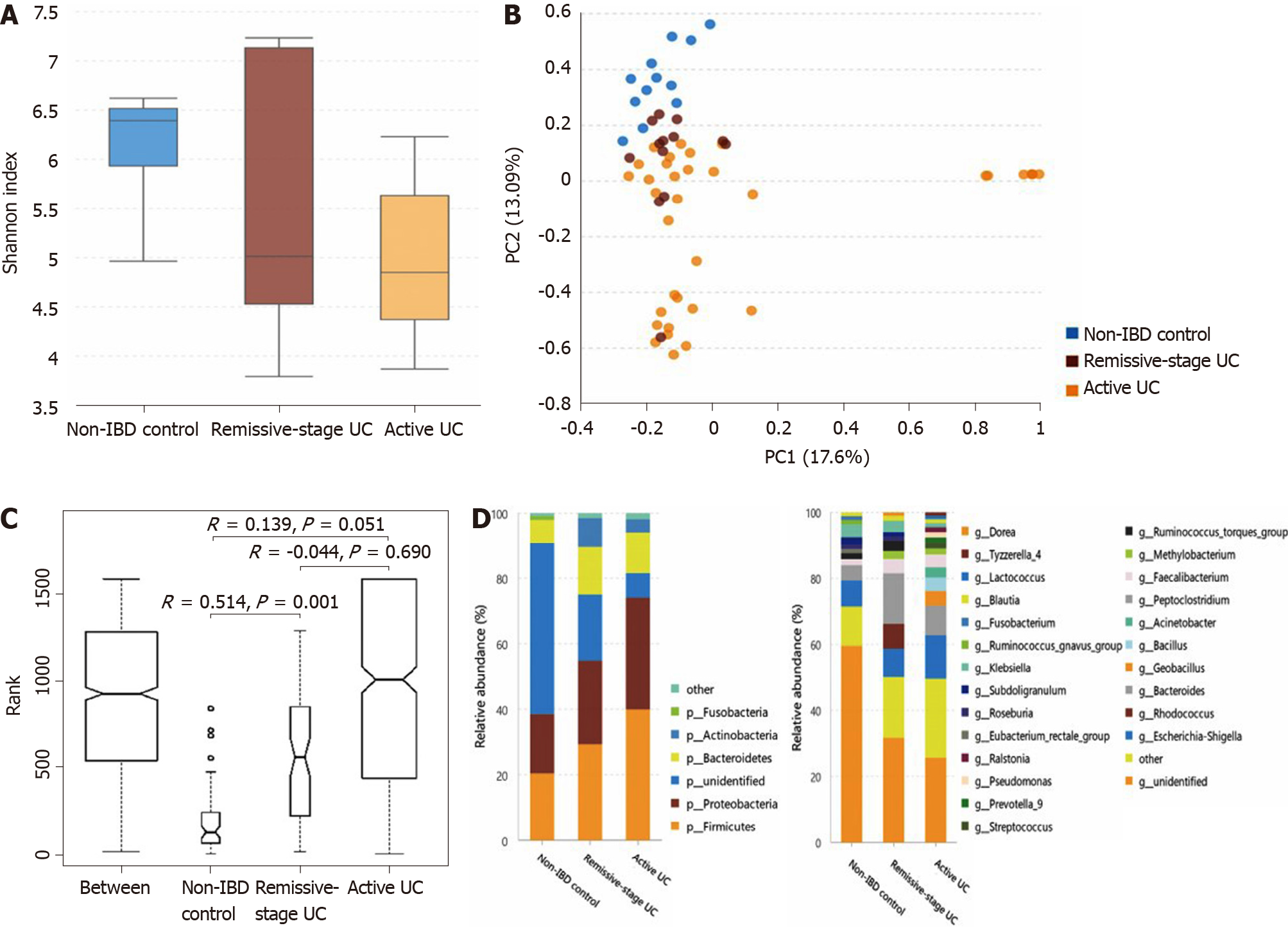Copyright
©The Author(s) 2021.
World J Gastroenterol. Jul 28, 2021; 27(28): 4722-4737
Published online Jul 28, 2021. doi: 10.3748/wjg.v27.i28.4722
Published online Jul 28, 2021. doi: 10.3748/wjg.v27.i28.4722
Figure 4 Statistical analysis of the sequencing results of the bacteria microbiota in mucosa samples from patients with ulcerative colitis and non-inflammatory bowel disease controls.
A: The α-diversity of microbiota evaluated by Shannon index. The ordinate shows the Shannon index, and the abscissa shows the groups. The α-diversity of mucosal microbiota in non-inflammatory bowel disease (IBD) controls (Shannon index, 6.12 ± 0.70) was similar to that in ulcerative colitis (UC) in remission (Shannon index, 5.63 ± 1.53; P = 0.682) but significantly higher than that of the active UC group (4.99 ± 1.02; P = 0.001). And the α-diversity of UC in remission and active UC showed little difference (P = 0.453); B: Principal component analysis. The flora structure of non-IBD controls was different from that of either UC group (with a PC1 of 17.6% and a PC2 of 13.09%, as showed in the abscissa and ordinate axis separately); C: The analysis of similarities. The intergroup difference between controls and UC in remission was significant (P = 0.001); D: The relative abundance of the bacteria at the phylum (the left bar graph) and genus (the right bar graph) levels. The ordinate shows the relative abundance (%), and the abscissa axis shows the sample types where the microbiota was sequenced from. At the phylum level, compared with non-IBD controls, the relative abundance of Firmicutes and Proteobacteria significantly increased in active UC, and that of Actinobacteria was significantly higher in both the active UC and UC in remission groups. The relative abundance of unidentified bacterial phyla obviously decreased in UC in remission and further decreased in active UC. At the genus level, the relative abundance of Geobacillus, Lactococcus, Pseudomonas, Methylobacterium, Acinetobacter, Streptococcus, Bacillus, and Ralstonia increased in active UC compared with non-IBD controls, while that of Ruminococcus torques group and unidentified bacteria genera decreased. When comparing the non-IBD controls and UC in remission, the relative abundance of Eubacterium rectale group and unidentified genera was lower in the latter while that of Methylobacterium, Rhodococcus, Peptoclostridium, and Faecalibacterium was higher. The difference between active UC and UC in remission was also obvious and more Geobacillus, Lactococcus, Pseudomonas, Streptococcus, Bacillus, Ralstonia, and Prevotella group 9 were observed in active patients with UC. IBD: Inflammatory bowel disease; UC: Ulcerative colitis.
- Citation: He XX, Li YH, Yan PG, Meng XC, Chen CY, Li KM, Li JN. Relationship between clinical features and intestinal microbiota in Chinese patients with ulcerative colitis. World J Gastroenterol 2021; 27(28): 4722-4737
- URL: https://www.wjgnet.com/1007-9327/full/v27/i28/4722.htm
- DOI: https://dx.doi.org/10.3748/wjg.v27.i28.4722









